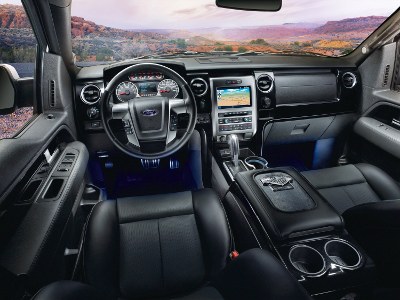 |
| January 17, 2012 | Volume 08 Issue 02 |
Designfax weekly eMagazine
Archives
Partners
Manufacturing Center
Product Spotlight
Modern Applications News
Metalworking Ideas For
Today's Job Shops
Tooling and Production
Strategies for large
metalworking plants
Wheels:
Study says CAFE standards create profit incentive for larger vehicles

2012 Ford Harley-Davidson F-150 V8. It may be large, but it sure is sweet. [Photo courtesy: Ford Motor Co.]
By Nicole Casal Moore, University of Michigan
The current Corporate Average Fuel Economy standards create a financial incentive for auto companies to make bigger vehicles that are allowed to meet lower targets, according to a new University of Michigan study.
Over their lifetimes, these larger vehicles would generate between three and 10 1,000-MW coal-fired power plants' worth of excess carbon emissions. A 1,000-MW plant could provide power for more than half a million people.
"This study illustrates that there may be a substantial financial incentive to produce larger vehicles, and that it can undermine the goals of the policy," says Kate Whitefoot, who conducted the research as a U-M design science doctoral student and is now a senior program officer at the National Academy of Engineering.
"The results show that the policy can be adjusted to reduce these unintended incentives by making it harder to lower the fuel economy targets by producing larger vehicles."
The study is published online in Energy Policy.
The loophole is the formula for setting mile-per-gallon targets. The standards, which actually depend on the sizes of vehicles automakers produce, are expected to require that firms boost average fuel economy to 35.5 mpg by 2016 and 54.5 mpg by 2025. Those oft-cited numbers are averages. In reality, each car company must meet a different standard each year determined by the literal "footprints" of the vehicles it makes. A vehicle's footprint is its track width times its wheelbase.
According to the study, the sales-weighted average vehicle size in 2014 could increase by 1 to 16 square feet, undermining fuel economy improvements between 1 and 4 mpg. That means the industry as a whole would not achieve that year's fuel economy goal.
"We know it's a broad range, but we looked at a large range of possible consumer preferences for vehicle attributes and the answer is probably somewhere in the middle," says Steven Skerlos, an associate professor in the U-M Department of Mechanical Engineering.
"Will cars get bigger? Very possibly," says Skerlos. "Will that lead to more pollution? Yes. And there wasn't an emphasis in the rulemaking process that this could happen."
The impetus for the footprint-based formula back in 2006 was to prevent an influx of smaller vehicles, though not necessarily to do the opposite. Critics worried that the previous one-size-fits-all standard unfairly and perhaps dangerously rewarded production of slimmer, lighter vehicles that could put the domestic industry at a disadvantage and drivers at greater risk. The researchers believe the correction overshot its target.
They found that light trucks would grow even more than cars, which could yet lead to traffic safety concerns. They call on the National Highway Traffic Safety Administration to revise the formula.
This study was more than just an economic analysis. Whitefoot built a first-of-its-kind model that considered supply and demand but also incorporated engineering tradeoffs that carmakers consider as well as a wide range of possible consumer preferences.
They conducted simulations with 473 different vehicles. In the simulations, auto firms could adjust the size of their vehicles, add fuel-saving technologies, balance acceleration performance with fuel economy, and adjust vehicle prices. The result, Skerlos says, is an exciting new framework where economists, environmentalists, engineers, and policymakers can work together.
"Sustainability is about tradeoffs," Skerlos says. "On the one hand, there's a concern about vehicle size largely driven by safety and the effect on domestic automakers. The adjustment to the CAFE standard tries to achieve high fuel economy while not compromising vehicle size, and the idea here is these things intersect and you have an equivalent of three to 10 coal-fired power plants hidden in that tradeoff."
The research is funded by the Michigan Memorial Phoenix Energy Institute and the National Science Foundation. The paper is titled "Design Incentives to Increase Vehicle Size Created from the U.S. Footprint-Based Fuel Economy Standards."
Rate this article
View our terms of use and privacy policy
